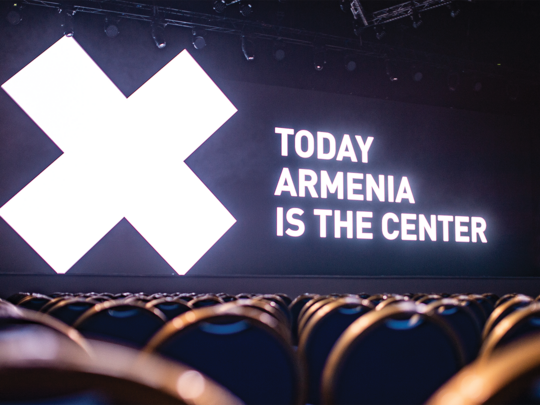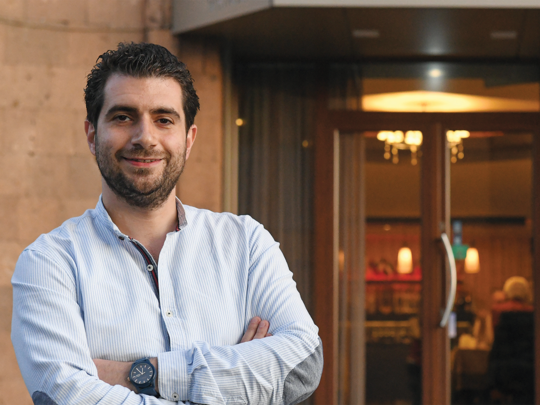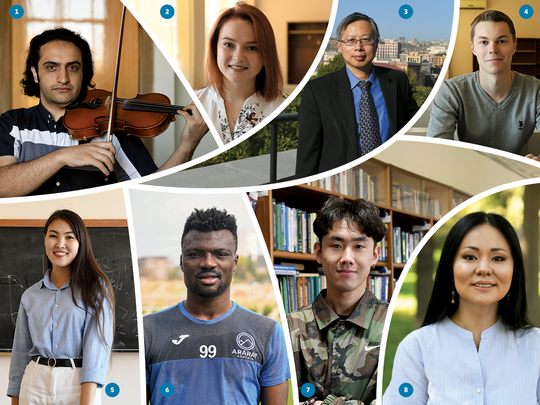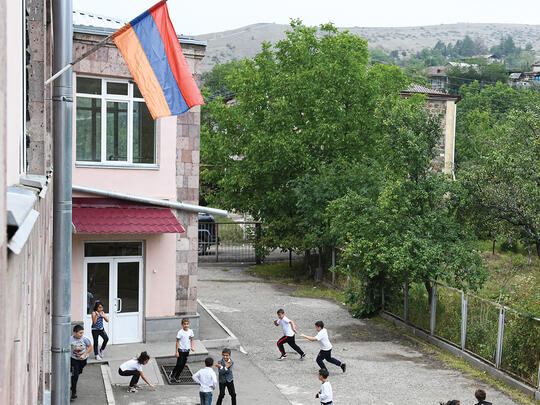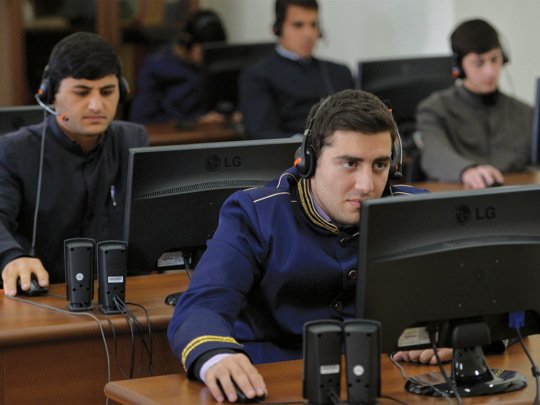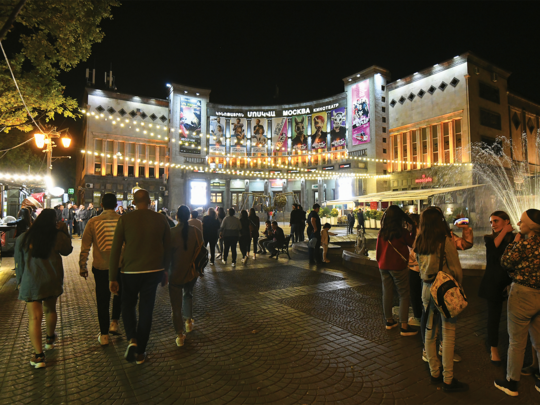In the fall of 2019, Amassia Niziblian, with a backpack slung over her shoulder, entered the Yerevan State Conservatory. Her footsteps echoed through the foyer overseen by a bronze bust of Gomidas Vartabed (also spelled Komitas Vardapet), the venerated icon who used the tools of European classical music to preserve Armenian folk songs. The conservatory, named after Gomidas, trains students in a rigorous classical and jazz curriculum that has produced countless internationally-acclaimed graduates. As Amassia descended a staircase, the contents of her backpack—a laptop, a synthesizer, grapes—shook. At the bottom of the steps, she met her partner Sona, the second half of the electronic music group Symptom, and they entered the room where their free show would take place.
The conservatory’s new leadership had already approved Symptom’s request to use part of the building’s basement for a rare electronic music performance. Though Amassia and Sona did not attend the school, they treated it like a second home. They wanted to bring their passion project to its halls, and introduce new audiences to the conservatory, while expanding the dimensions of artistic expression within its thick tuff walls. Liaisons from the student council initially facilitated Symptom’s preparations. Everything was set, including a spread of refreshments the band members provided. It was curtains up. Then things went downhill.
Shortly after their first song, members of the student council approached the performers and demanded they end the show. Perplexed, Symptom tried to continue, but the detractors flicked on the lights of the room and continued to demand a hard stop, warning that the police were coming to break up the concert. They even charged Symptom with peddling Satan’s music and drugging the grapes they had brought as snacks. In the ensuing days, Symptom had been accused of witchcraft, and spreading a demonic agenda that subverted the sanctity of Armenian music.
The incident reflected a debate about the very definition of Armenian music. What exactly is it, and who gets to define it? For some, it might be in the timbre of a blaring zurna, or the tinny tone of a tar. For younger generations, it could be the voice of a rabbiz singer, or a Sirusho pop ballad. What about Alicia Keys crooning “A Woman’s Worth” accompanied by Jivan Gasparyan’s duduk?
This collision of genres—sacred, secular, folk, jazz, classical, traditional, electronic, rabbiz, fusion, and beyond—frames a discussion about what it means to make music in Armenia. As in any free society open to the world and its ideas, this dialogue enjoys perspectives enriched by the diverse cultures shaping life in the republic. To better understand the evolution of Armenian music, it is important to consider how practitioners weave a variety of musical threads into their artistic fabric.

The Naghash Ensemble, for example, sets the poetry of the medieval Armenian priest Mkrtich Naghash to original compositions by John Hodian. Born in Philadelphia’s vibrant Armenian community, Hodian has performed in Armenia extensively, recruiting local talent to present his compositions. The group incorporates folk instrumentation to deliver an idiosyncratic style that blends classical, rock, jazz, and folk into a sound that transcends the limits of genre. Hodian found an unlikely inspiration for bending the strictures of tradition. In a recent interview, he remarked on the way Gomidas “took Armenian folk music, and then combined it with new technologies of the time: the European tuning system, European instruments, pianos, string quartets. This is not Armenian stuff. This is his deep knowledge of Armenian folk music combined with his classical training. So most of the people who we hold up as the tradition of Armenian music, in their lifetime they were radicals.” Hodian was pointing to an impulse among innovators to expand the meaning of creativity by engaging cultures and technologies that shape a modern moment. This approach increasingly characterizes how contemporary Armenian musicians are writing the next chapter of an ancient artistic story.
In his 2015 album Luys I Luyso, acclaimed jazz pianist Tigran Hamasyan, a native of Gyumri, fused the chilling chants of Armenian sacred music with his ethereal harmonic textures. During the Velvet Revolution, the Viking Thunder Clap used a thumping rhythmic acceleration to unite thousands of protestors. And in the fallout from the Syrian Civil War, a new wave of Armenian musicians, like Nour Band, whose members hail from Aleppo, have brought the sounds of the Levant and Anatolia—rich with odd time signatures and microtonal melodies—back into local soundscapes. The aforementioned constitute but three of countless examples illustrating the unique renderings that Armenian music has undergone in the past decade. To understand how that discussion might progress in the next ten years, it is instructive to consider the past decade, and observe how bursts of progress do not arise without growing pains.
Despite the paltry wages most working musicians earn around the world, Armenian commitment to the art form remains robust. In the past decade, a bevy of investments from public and private sources have helped support practitioners and cultivate the platforms necessary to elevate local standards to meet industry best practices. The Naregatsi Art Institute (NAI) represents one such proponent. Since 2002, NAI has become a cultural hub for innovative groups to form, present, and publish their work for international audiences. A recent 2016 per-formance by the Naregatsi Orchestra featured an ensemble of some thirty young folk musicians. Clutching their ouds, duduks, kanons, and more, they played a stunning arrangement of System of a Down’s metal hit Aerials. NAI also maintains a folk instrument ensemble, folk dance group, and a wide variety of classes available in their Yerevan and Shushi centers. The institute balances a preservation of the spiritual and secular traditions through inventive, modern applications. This emerges from the philosophy motivating NAI founder Nareg Hartounian, who believes in the transformative power of music and art. “From the very first moments we opened our doors,” Hartounian shared, “it was very important that everything was done for the love of art.” Opportunities to create and experience art in an Armenian context are, for Hartounian, nothing less than a spiritual quest. “Music can purge. It can heal. There are so many pieces of Armenian music that can connect you with new dimensions of reality, and it’s very important to nurture.” Hartounian stressed the importance of preserving the art, and for individuals and organizations to do more to secure a rich cultural inheritance for the next generation. NAI is not the only non-profit fostering the necessary infrastructure for musical artists.

Music of Armenia (MOA) has committed itself to empowering musical artists in the republic through platforms, resources, and collaborations. With a passion for Armenian artistry driven by founder Hasmik Movsisian, MOA has helped untold numbers of Armenian musicians create and release art into the world. They have also upped performance opportunities. For a nation that loves its festivals, MOA jumped in with festivals dedicated to duduk, sharakans, and Sayat Nova. And in alignment with International Women’s Day (March 8), MOA organized Women’s Musical Month, “which focuses on the power of female creativity and talent and promotes the legacy of music created by Armenian women,” according to its website. Working in conjunction with the Ministry of Education, Science, Culture, and Sport, MOA also seeks to resolve basic limits, such as restrictions on content creators in Armenia uploading work to Spotify, or joining the YouTube Creator benefits program. These important tools allow musicians in Armenia to reach global audiences. As the world continues turning toward digital hardwares and softwares, new generations of musicians will integrate their knowledge of art and technology.
At TUMO Center for Creative Technologies—a pathbreaking afterschool and summer learning center with locations in Yerevan, Gyumri, Dilijan, Stepanakert, Beirut, and Paris—teens make music alongside thirteen other digital media learning areas. A wide variety of projects have emerged from this space, including the all-girl’s band Decibelle, and the TmbaTa Orchestra, which recently appeared at the Smithsonian Folklife Festival in Washington, D.C. Arik Grigoryan, multi-instrumentalist and member of the multi-generational rock outfit The Bambir, leads TmbaTa and other musical ventures at TUMO. His pedagogical ethos is simple: push buttons with intention. The technology, he says, will not generate beautiful art alone. “You push a button and something happens,” he says. “A beat emerges. But how do you use it? That’s what’s important.”
This spirit of technology driven by aesthetic intention was on full display in Armenia during the October 2019 WCIT conference, a preeminent gathering of leaders in the global information technology sector. Under conductor Sergey Smbatyan’s baton in Republic Square, the WCIT Orchestra performed music created in real time by artificial intelligence. The AI outputted a composition informed by musical traditions from the 15 countries that the 100 orchestra members called home. Never before had such an ambitious weaving of human and technological artistry taken place. Later, internationally-acclaimed DJ Armin van Buuren joined the orchestra in a collaboration, adding a new layer of musical complexity dramatizing the coexistence of art and tech, of folk and futurism: Python and khaz, Java and shvi, bits and dhols.
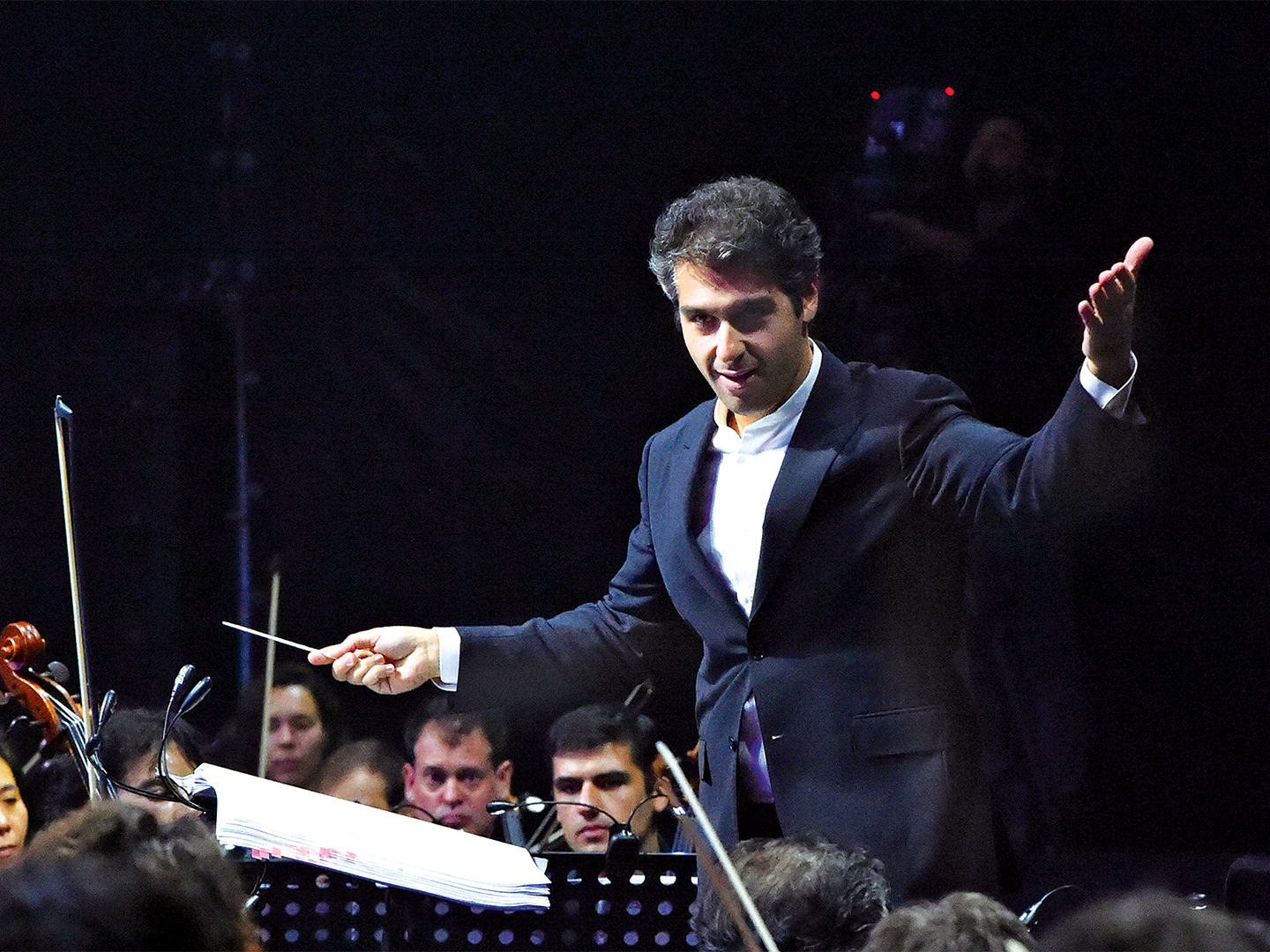
TmbaTa, Decibelle, and other ensembles at TUMO extend a principle of inclusive pedagogy that prepares future leaders to collaborate and harness technology to elevate, not replace, their own aesthetic ingenuity. Just a few decades ago, the pedagogical landscape differed.
During the Soviet period, students enjoyed exposure to the fundamentals of Armenian sacred and secular music. They learned about Aram Khatchaturian and European classical giants, sparking Armenia’s continuing love affair with the genre. Throughout this period, Armenia stood apart for its disproportionate number of classical music prodigies and virtuosos, winning international competitions and admission into the world’smost prestigious conservatories. It is this legacy on which the Armenian National Philharmonic Orchestra stands today, still romancing the masses with its rich repertoire of European and Armenian classics. Under the direction of Maestro Eduard Topchjan, it has hosted many renowned conductors including Aram Khachaturian, Dmitry Kabalevsky, and Krzystof Penderecki. It currently performs classical, operatic, national, and contemporary genres and also hosts an annual music festival during its fall season, attracting tourists, opera-lovers and locals alike.
At the same time, musical trailblazers in Soviet Armenia found themselves in a censored world of cultural and ideological conformity, making all the more remarkable breakthroughs by artists like The Bambir, Ruben Hakhverdyan, Arthur Meschian, Datevik Hovannisian, and many others. Their accomplishments reinforced the notion that creativity is a choice that transcends the boundaries of any institution, no matter how stifling or empowering.
Following independence, Armenia enjoyed access to educational methodologies prevalent beyond the Iron Curtain, even as the war with Azerbaijan and fragile economy contributed to a widespread sense of fear that, arguably, undermined the country’s creative potential. A positive outcome was not a given. Rather, it resulted from the time, energy, and resources provided by those who understood how forward-thinking pedagogy could transform communities for the better.
At Nexus Center for the Arts, toddlers bang on buckets, and tweens slap funky grooves on bass guitars. A product of Armenia’s rigorous classical instruction which led her to the New England Con-servatory, Nexus founder Anna Mikaelyan noticed the empowerment students experience when they play with, not to, their mentors and contemporaries. Nexus afterschool and summer programming offers youth and adults opportunities to learn music by creating it. Children as young as three years old form ensembles that promote experimentation, teamwork, and exposure to a combination of folk, improvised, and popular music. Ear training is equal to, if not more important than, sight-reading. Older youth participate in a refined variation of this model, with opportunities to form rock bands. Nexus is not a means to an end, but a stepping stone on an emergent alternative path for Armenia’s young people to engage with an ancient, sacred art form. What you play and how you play is becoming as important as where you’ve played. Ultimately, the goal is to cultivate motivation that is not extrinsic (please others), but instead, intrinsic, flowing from an internal wellspring of love. This approach elicits, according to Mikaelyan, “enjoyment, which brings life into the music, and their music becomes interesting and unique and expresses their individuality.”
As students mature and form their own groups, opportunities to perform abound. Traditional concert halls like the Yerevan Opera Theatre and Malkhas Jazz Club continue to present a rich canon of traditional repertoire. Simultaneously, the country has seen an expansion of venues. In Gyumri, for example, Garage Music Club has welcomed DJs, rockers, and other genre-benders from around the world while serving the demand outside of Yerevan’s city center. The Urvakan Electronic Music Festival has, likewise, reimagined what it means to present music in Armenia. In 2019, they brought 80 artists from 22 countries to showcase “current trends in sonic arts, contemporary electronic, instrumental, avant pop, and club music.” They did not perform in posh Yerevan clubs, or a tripped-out stage near gushing fountains. Instead, they repurposed an abandoned site, specifically the Yerevan Children’s Railway in the Hrazdan Gorge. For a country with abundant unused structures, the implications of Urvakan’s approach could be profound.
The next decade for music in Armenia is positioned to build on the developments of the past ten years. Educators like those at TUMO and Nexus will have opportunities to continue encouraging innovation, access, and community. Meanwhile, mainstay institutions of classical and jazz music are positioned to maintain Armenia’s preeminence in the global classical and jazz arenas. Throughout the republic, a new wave of artists will very likely enjoy unprecedented access to genres and approaches to music that reflect the imagination, discipline, and equity of a new post-revolutionary era.
Listen to the 2020s. You might be surprised by what you hear.
Banner photo courtesy of Naregatsi Art Institute


